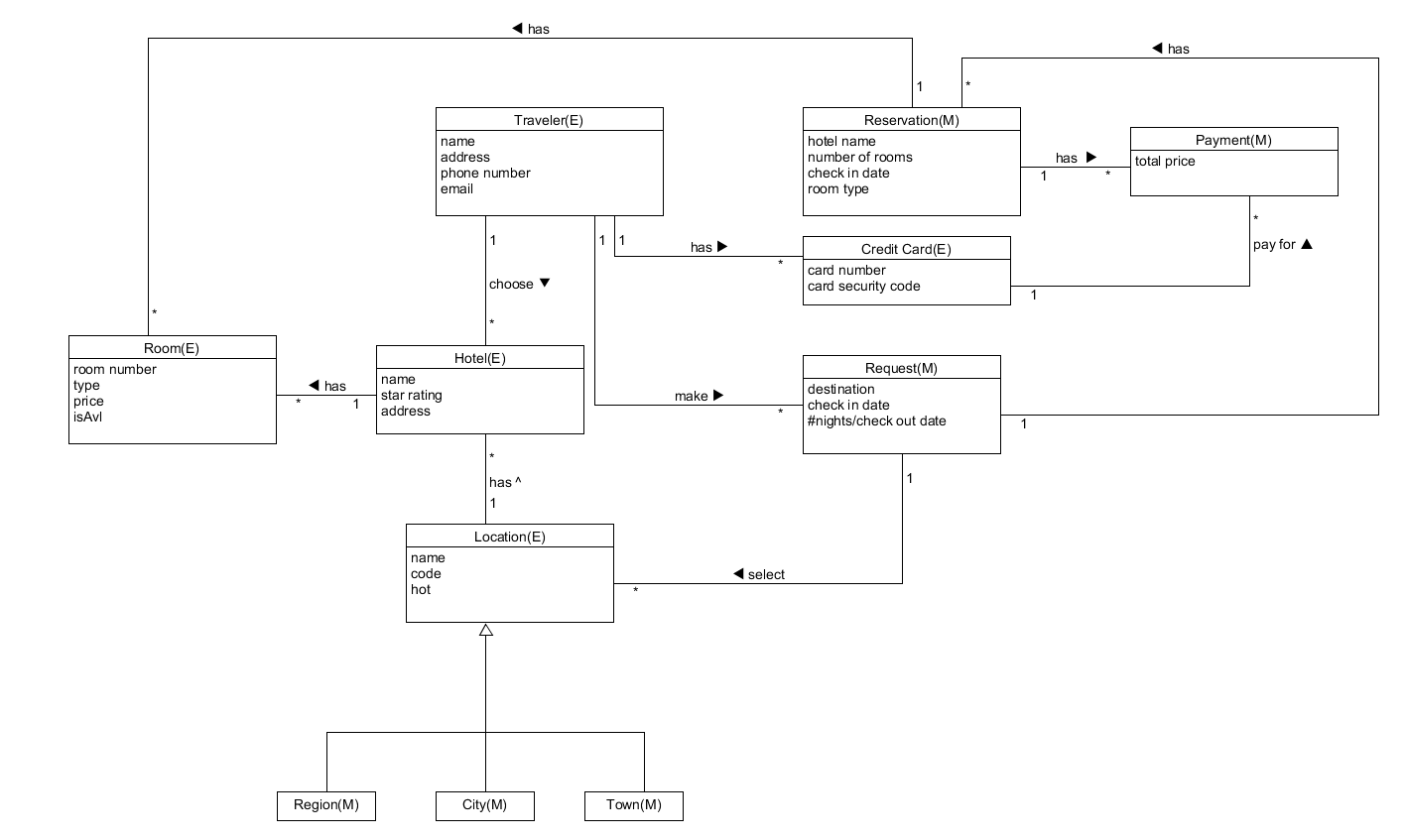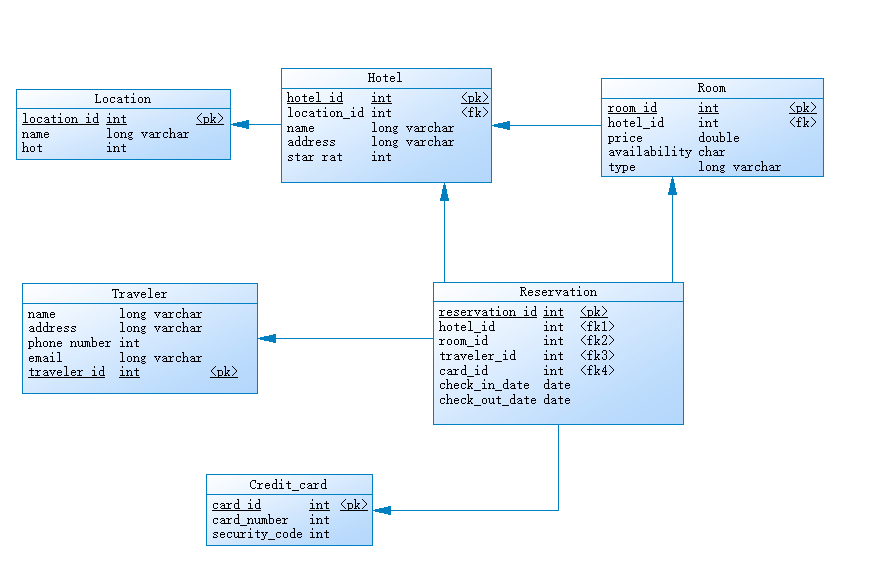a. 阅读 Asg_RH 文档,按用例构建领域模型。

b. 数据库建模(E-R模型)
- 按 Task 3 要求,给出系统的 E-R 模型(数据逻辑模型)
- 导出 Mysql 物理数据库的脚本
- 简单叙说 数据库逻辑模型 与 领域模型 的异同
导出脚本:1
2
3
4
5
6
7
8
9
10
11
12
13
14
15
16
17
18
19
20
21
22
23
24
25
26
27
28
29
30
31
32
33
34
35
36
37
38
39
40
41
42
43
44
45
46
47
48
49
50
51
52
53
54
55
56
57
58
59
60
61
62
63
64
65
66
67
68
69
70
71
72
73
74
75
76
77
78
79
80
81
82
83
84
85
86
87
88
89
90
91
92
93
94
95
96
97
98
99
100
101
102
103
104
105
106
107
108
109
110
111
112
113
114
115
116
117
118
119
120
121
122
123drop table if exists Credit_card;
drop table if exists Hotel;
drop table if exists Location;
drop table if exists Reservation;
drop table if exists Room;
drop table if exists Traveler;
/*==============================================================*/
/* Table: Credit_card */
/*==============================================================*/
create table Credit_card
(
card_id int not null,
card_number int null,
security_code int null,
constraint PK_CREDIT_CARD primary key clustered (card_id)
);
/*==============================================================*/
/* Table: Hotel */
/*==============================================================*/
create table Hotel
(
hotel_id int not null,
location_id int null,
name long varchar null,
address long varchar null,
"star rat" int null,
constraint PK_HOTEL primary key clustered (hotel_id)
);
/*==============================================================*/
/* Table: Location */
/*==============================================================*/
create table Location
(
location_id int not null,
name long varchar null,
hot int null,
constraint PK_LOCATION primary key clustered (location_id)
);
/*==============================================================*/
/* Table: Reservation */
/*==============================================================*/
create table Reservation
(
reservation_id int not null,
hotel_id int null,
room_id int null,
traveler_id int null,
card_id int null,
check_in_date date null,
check_out_date date null,
constraint PK_RESERVATION primary key clustered (reservation_id)
);
/*==============================================================*/
/* Table: Room */
/*==============================================================*/
create table Room
(
room_id int not null,
hotel_id int null,
price double null,
availability char null,
type long varchar null,
constraint PK_ROOM primary key clustered (room_id)
);
/*==============================================================*/
/* Table: Traveler */
/*==============================================================*/
create table Traveler
(
name long varchar null,
address long varchar null,
"phone number" int null,
email long varchar null,
traveler_id int not null,
constraint PK_TRAVELER primary key clustered (traveler_id)
);
alter table Hotel
add constraint FK_HOTEL_REFERENCE_LOCATION foreign key (location_id)
references Location (location_id)
on update restrict
on delete restrict;
alter table Reservation
add constraint FK_RESERVAT_REFERENCE_HOTEL foreign key (hotel_id)
references Hotel (hotel_id)
on update restrict
on delete restrict;
alter table Reservation
add constraint FK_RESERVAT_REFERENCE_ROOM foreign key (room_id)
references Room (room_id)
on update restrict
on delete restrict;
alter table Reservation
add constraint FK_RESERVAT_REFERENCE_TRAVELER foreign key (traveler_id)
references Traveler (traveler_id)
on update restrict
on delete restrict;
alter table Reservation
add constraint FK_RESERVAT_REFERENCE_CREDIT_C foreign key (card_id)
references Credit_card (card_id)
on update restrict
on delete restrict;
alter table Room
add constraint FK_ROOM_REFERENCE_HOTEL foreign key (hotel_id)
references Hotel (hotel_id)
on update restrict
on delete restrict;
简单叙说 数据库逻辑模型 与 领域模型 的异同
- 相同点:都对实际问题进行抽象,描述了实体和实体间的关系,更加直观的展示了彼此间的关系
- 不同点:领域模型的重点在于将用例中的概念都一一列出,更加注重需求分析方面的联系,注重整个业务流程;而数据库逻辑模型是面向软件开发的模型,因此在数据库逻辑模型中,有属性的类型,主键,外键等,更加注重数据库结构的设计。
